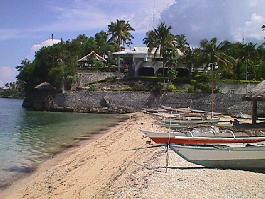 |
-
Past Capitan Municipal and Mayors are as follows:
-
-
-
-
-
BERNARDINO MONTELLANO
-
CARLOS ARPON
-
ZACARIAS MONTELLANO
-
PASCUAL NEIS
-
BENIGNO HEYRANA
-
CATALINO MONTELLANO
-
CRISPIN HORTELANO
-
CATALINO ROMAGOS
-
BERNARDINO ARNOCO
-
ESTEBAN NOLASCO
-
BONIFACIO YAP
-
ESTEBAN MALAZARTE
-
JESUSA BOOK
-
TRINIDAD MANLOLOYO, JR.
-
BEATRIZ YBAÑEZ
-
MANOLO LECHIDO
-
ARMANDO SERAFIN
-
ROY ORNOPIA
|
|
-
According to handed-down legend of the Municipality, the Municipality was once known as "Agoho" because it was somewhere around a tree of this species, where the first know settlement in the area was established. The tree was very huge and its foliage very thick. The tree became a landmark and eventually the place came to be known by it.
-
Then came wave after wave of Moro marauders in their fast vintas and with razor-sharp kris. Their shouts, as they attacked, brought paralyzing fear into the hearts of the people. Their only alternative was to free to nearby hills whenever the Moros came.
-
In the 16th century, the Spaniards came. They helped in the resettlement of the people, who called their hiding place "Tabogon" as a reminder of their many experience in the hands of the Moro pirates. Thus the name "Agoho" passed into oblivion, replaced by the new name, which up to the present the Municipality is called. Upon being converted to Catholicism, the people built a big church, a rectory and a bellfry. These were built of bricks and stones and in the area where a portion of the land extends towards the Visayan Sea. These buildings, being large and massive, also served as shelters where the people can hide, in the case the Moro pirates came back. Two schools, one for boys and another for girls, were constructed near the church and the rectory. It was constructed through free labor by all able-bodied men of the locality under the so-called "Pentacase" system. After many years, these buildings were destroyed and were never rebuilt. Now rubbles of their ruins can still be seen on the places where they once stood. Tabogon became a town and the people elected Pablo Hortelano as its first Capitan Municipal. During his term he proposed and enacted the transfer of the townsite to another place, then called Tagasa, 3 kilometers north of its former location. The name Tabogon was retained.
-
-
Two events that bring color to the history of Tabogon, after it became a town, will have to be related. These are:
-
-
1. The Battle of Canao-canao Hills. this was battle between a group of Filipino rebels and Spanish soldiers. Because it was an uneven battle between Filipino bolos and Spanish rifles, the rebels lost more than a hundred, compared to the 4 Spaniards dead. Nevertheless, it showed the firm intent of the Filipino then to get off the Spanish yoke, which hang on their backs for almost 400 years.
-
-
2. The Capture of the Notorious Tan Pitong. This man, also known as Perfecto Esnardo, was the most notorious bandit of the area during the early 20th century. He and his men were firmly entrenched in the mountains vastness of Tabogon. From there the Governor of the Province, decided to do something about the problem. Together with the town's chief of police, Juan Urot, and a few constabulary agents, the Governor went to Sitio Natin-ao, where Tan Pitong and his men were hiding. Without firing a shot, the Governor was able to secure an unconditional surrender from Tan Pitong.
|